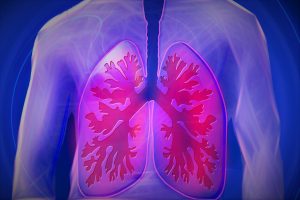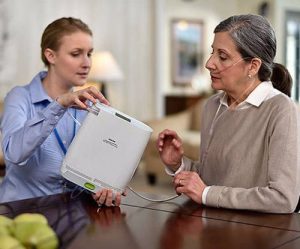What is Pulmonary Fibrosis?
You may think pulmonary fibrosis is just one disease. In reality, there are over 200 types of this lung condition that are each very similar. They are characterized by lung scarring that irreversibly damages healthy lung tissue over time, making them stiff and stripping them of their elasticity.
This makes it harder to breathe because oxygen cannot enter your bloodstream as easily, resulting in feeling short of breath even when simply going for a walk. Lungs affected by pulmonary fibrosis get smaller and their capacity to hold air is reduced.

Multiple factors may contribute to the cause of developing pulmonary fibrosis, but sometimes it is difficult for physicians to determine what exactly is causing the disease to progress. Here’s everything you need to know about pulmonary fibrosis and how to begin oxygen therapy as soon as possible.
What Causes Pulmonary Fibrosis?

Around 50,000 new patients are diagnosed with pulmonary fibrosis every year and begin showing symptoms when they are 50-70 years old, although it can happen to patients of any age. The most common type is idiopathic pulmonary fibrosis (IPF), for which there is no known cause. However, there are a few causes of this lung disease that can be diagnosed directly:
- Certain heart medications like amiodarone, drugs used in chemotherapy, and antibiotics like nitrofurantoin can negatively impact the lungs
- Occupational hazards such as the inhalation of asbestos, fumes, dust, and fibers
- Environmental exposure to mold or animal droppings
- Radiation treatments localized to the chest
- Autoimmune illnesses like rheumatoid arthritis, scleroderma, abnormal blood tests, and inflammation of the joints
- Genetics that suggest there is history of pulmonary fibrosis present in your family
- Smoking is a big risk factor for developing PF
What are the Symptoms of Pulmonary Fibrosis?

There is no set blueprint for what symptoms you might experience once you are diagnosed. This is because symptoms vary among everyone with pulmonary fibrosis, as everyone encounters different symptoms and manifestations of their condition.
Patients could either be faced with severe symptoms or mild ones without little to no decline in their overall health for years to come. Symptoms may be virtually nonexistent for a long time and suddenly flare up unexpectedly. Pulmonary fibrosis is a highly unpredictable disease whose symptoms are impossible to foretell.
You might need to speak with your primary doctor about pulmonary fibrosis if you are experiencing any of the following:
- Consistent dry cough
- Shortness of breath or shallow breathing
- Gradual and unplanned weight loss
- Pain in the muscles and joints due to clubbing (when the fingers and toes start to round and widen)
How is Pulmonary Fibrosis Diagnosed?

In order to properly diagnose someone with pulmonary fibrosis, a physician will first take a close listen to your breathing patterns. If abnormalities are detected, further tests might be advised by the doctor to narrow down what is causing it. There are certain things the doctor will be able to notice right away, and any other tests suggested to you are to discover signs that are not-so-obvious.
If the patient’s lungs have to put in double the work just to get a breath out, they have likely developed stiff lungs caused by inflammation and the buildup of scar tissue. The brain will let you know there is a struggle to stretch your lungs to full capacity by triggering heavy breathing when you become active.
The physician might perform a Pulmonary Function Test that requires the patient to breathe forcefully through a tube. This test measures how much air your lungs can actually hold.
Crackles or “rales” heard while breathing are a tell-tale sign of many types of lung issues that affect the air sacs in the lungs.
You might need to take an oximetry test to determine what your blood oxygen levels are. Scar tissue may be obstructing the flow of oxygen to your bloodstream, causing you to feel breathless when you exert yourself. A small device will be placed on your finger to track the oxygen saturation levels in your blood.
A chest X-ray might also be required to see the full extent of scar tissue that has accumulated on the lungs. These HRCT scans provide you with a closer view of the lungs than a regular CT scan will. There are times when a doctor might need to take a tissue sample from the patient’s lungs to more accurately determine the presence of pulmonary fibrosis.
After all these the tests and questions a patient will undergo in order to learn if they have pulmonary fibrosis, doctors are often unable to determine which type of PF the patient has.
How is Pulmonary Fibrosis Treated?

Currently, the advancement of pulmonary fibrosis cannot be cured once it begins to progress. There are treatments available that may slow the scarring process or help manage symptoms. The healthcare provider may choose to place a patient with PF on certain medications that will provide some relief, and many will suggest other practices like pulmonary rehabilitation or supplemental oxygen therapy.
Pulmonary rehabilitation is designed to help those diagnosed with PF strengthen their breathing muscles and improve their overall well-being through exercise. Depending on which program you are prescribed by your physician, you might also learn how to manage stress, anxiety, and learn a lot about your condition.
Supplemental oxygen therapy is provided by a device the patient wears while breathing through a mask or nasal cannula. A healthcare provider might recommend using supplemental oxygen only during sleep, during active periods of your day, or to be worn consistently. This is to ensure your blood gets the vital oxygen it needs to function and help you breathe easier.
Supplemental oxygen has the ability to significantly improve life expectancy and the quality of life of not only patients with pulmonary fibrosis, but of anyone with a lung disease. To learn more about the hugely beneficial effects of supplemental oxygen, read about it here.
In some cases, the PF patient will need to undergo a lung transplant in order to improve their lives. Today, pulmonary fibrosis is the leading cause of lung transplants in the United States, but there are always risks to consider before making this choice. Be sure to discuss it in detail with your physician before moving forward.
How Can I Start Supplemental Oxygen?

Liberty Medical specializes in delivering reliable home oxygen concentrators as well as lightweight, portable oxygen concentrators to those diagnosed with a lung disease, mild or severe.
Our portable devices are widely used by our more active patients and by those who need to be on oxygen 24/7. They are FAA approved and can be brought on flights for when you need to see your loved ones throughout the year. We want you to be able to breathe better and enjoy living your life to its fullest, giving you the care you need and deserve.
Give us a call at 1-800-375-6060 and we will create the perfect oxygen solution for you. Browse our POC blog to find detailed information on each of the portable and home oxygen concentrators we offer. You have the option to purchase or rent one from our website. Call our 24/7 support line and ask about our helpful financing plans so we can assist you with your supplementary oxygen needs today! www.traveloxygen.com


